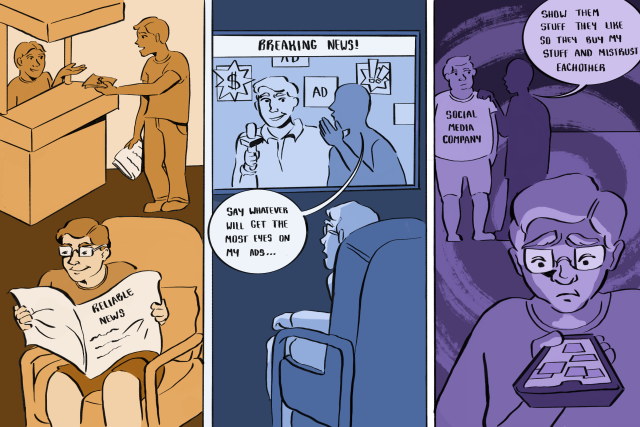[ad_1]
In a world where information is more accessible than ever, I, like many Americans, find myself increasingly skeptical of the news I consume. Once-trusted sources of factual reporting now feel tainted by bias, sensationalism and ulterior motives. This distrust is not born out of cynicism, but is instead rooted in the troubling evolution of how society produces and disseminates the news.
The decline of trust in news organizations is driven by a broader issue: the infiltration of advertising and money into journalism, which has transformed the news from a public service into a commodity. This transformation, driven by the desire for free access to information, has culminated in what some have coined the post-truth era — where facts are malleable and institutional trust is eroding.
In its early days, network news functioned as a public good, a way to provide people with unbiased, factual information. Congress provided news organizations with free access to the airwaves, with the understanding that news outlets would use this privilege to provide one hour of information broadcasting each night. This was the beginning of what we now know as the nightly news.
However, this model was flawed from the start. Congress, ignorant of the powerful influence television would come to have on the public conversation, did not stipulate that the hour should be free from advertising. As a result, the news quickly became intertwined with commercial interests. To remain profitable, news organizations turned to advertisers, and content began to shift. The focus on delivering important, factual information gradually gave way to sensationalism and entertainment. After all, sensational stories attract more viewers, and more viewers yield higher advertising revenue.
This shift had profound implications. News organizations depending on advertising dollars blurred the line between news and entertainment. Stories more likely to capture the public’s attention — often those that were more shocking, controversial or emotionally charged — began to dominate the airwaves. The consequence was a news landscape increasingly driven by what would sell rather than what was important or true.
The internet only amplified these issues. It promised to democratize information, making it accessible to everyone; however, the reality was more complex. As traditional news outlets moved online, they brought with them the same reliance on advertising that had plagued network news. The race to attract views led to a proliferation of clickbait headlines and sensationalist content, further eroding the quality of news.
Moreover, the internet introduced a new dynamic: the ability for individuals to curate their own news sources. This phenomenon has given rise to online echo chambers, where people seek out information that confirms their existing beliefs while ignoring or dismissing anything that challenges them. In these echo chambers, bias is not only tolerated, but often reinforced, leading to an increasingly polarized public.
The consequences of this new paradigm are far-reaching. When individuals are only exposed to information that aligns with their views, they become less willing to engage with differing perspectives. This not only deepens societal divides, but also undermines the very notion of objective truth. The internet, rather than being a tool for enlightenment, has become a breeding ground for misinformation and confirmation bias.
If the internet amplified the problem, social media, specifically, has taken it to new heights. Social media platforms, driven by algorithms designed to maximize engagement, have cultivated environments where sensationalism thrives. These algorithms prioritize content that is likely to elicit strong emotional responses — like anger, outrage and fear — because such content keeps users engaged longer, which in turn generates more ad revenue for the platforms.
The result is a social media landscape where misinformation spreads like wildfire. In such an environment, it is increasingly difficult to discern fact from fiction. The constant bombardment of biased or outright false information has led to widespread distrust, not only in news organizations but in institutions more broadly. People are more likely to question the legitimacy of the news they consume and, by extension, the legitimacy of the institutions the news represents.
This erosion of trust has profound implications for society. In a world where individuals are increasingly unwilling to trust anyone they do not know personally, the very fabric of social cohesion begins to fray. Without trust in our institutions — whether they be governmental, educational or media-related — the ability to engage in meaningful dialogue and democratic processes is severely compromised.
Hence, we now find ourselves in the post-truth era. In this era, objective facts are often less influential in shaping public opinion than appeals to emotion and personal belief. The term “post-truth” reflects a reality where truth has become subjective, and where the lines between fact and fiction are increasingly blurred.
If we are to restore trust in our news institutions and navigate our way out of the post-truth era, we must rethink our approach to news. This could involve supporting alternative funding models for journalism, such as subscriptions or public funding, which do not rely on advertising revenue. It could also involve promoting media literacy and encouraging media organizations to seek out diverse perspectives.
Ultimately, the responsibility lies with all of us. We must demand more from our news organizations, hold them accountable for their biases and be willing to pay for quality journalism. Only then can we hope to rebuild trust in the news and restore the integrity of the information we rely on to make informed decisions in our lives.
In a world increasingly dominated by misinformation and bias, the truth matters more than ever. It is up to each of us to seek it out, defend it and ensure that it remains at the heart of our democratic society.
Seth Gabrielson is an Opinion Analyst who writes about the intersection of politics, science and philosophy, while studying physics, philosophy, aerospace engineering and German. He can be reached at semiel@umich.edu.
Related articles
[ad_2]
Source link











